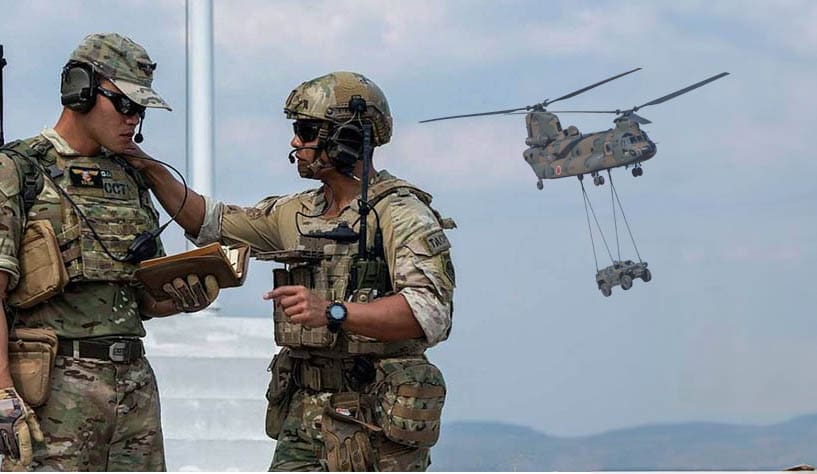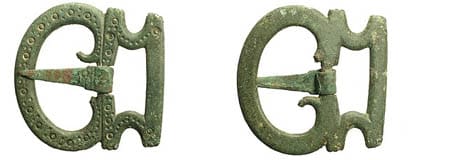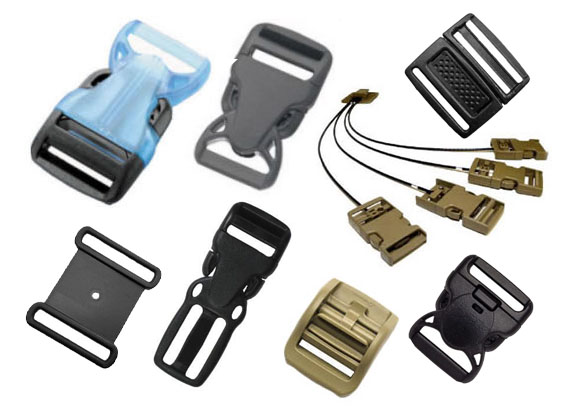Imagine this…you’re in battle, risking your life…running into a war zone with your fellow warriors beside you. Then…your tactical belt buckle breaks! Specifically, the belt buckle that is holding up your pants, your pistol, canteen AND other gear. Now your pants start coming down! Bullets are flying but you’re losing ground while getting shot at. Now you’re life depends on holding your pants up and keeping your equipment belt from falling down further. That scenario might be good for a comedy movie but on the battlefield you can’t have that happen! You need your your belt buckle AND every other buckle to work without you worrying about it.
John Howard Company understands the importance of providing quality built, durable equipment and tactical hardware that our soldiers and police) can depend on. When you’re life’s on the line and the pressure is high your plastic hardware and buckles should be trustworthy, solid and reliable. As a soldier, your tactical buckles need to work flawlessly so you can do your job, carry your gear (and pants) without thinking about them failing you during the height of a mission critical situation.
John Howard is proud to support the US Military with a wide range of tactical plastic buckles and plastic hardware.
BELOW are just a few examples of our military grade tactical buckles and hardware…

If your operation requires Berry Compliant, military plastic hardware and buckles we invite you to contact us today!

A Short History of Buckles
Today’s modern buckles have evolved out of centuries of use. Buckles, as a means of fastening and securing, have been used for centuries. The exact origin of buckles is difficult to determine, as they were likely developed independently in different regions. However, evidence suggests that buckles have been in use since ancient times.
The earliest buckles were made of materials such as bone, antler, and natural fibers. They were used for a wide range of purposes, including fastening garments, shoes, belts, armor, and harnesses. The designs and materials of buckles evolved over time, with metal buckles becoming more prevalent as metalworking techniques advanced.
As for plastic buckles, they emerged much later with the development of synthetic materials. Plastic buckles became popular in the mid-20th century as advancements in polymer technology allowed for the production of durable and lightweight plastics. This marked a significant shift in buckle manufacturing, as plastic buckles offered advantages such as cost-effectiveness, corrosion resistance, and a wide range of design possibilities.
The exact timeline of when plastic buckles were invented can vary depending on the specific type of plastic buckle. However, the mid-20th century saw the rise of plastic buckles in various industries, including outdoor gear, luggage, clothing, and other consumer products. The use of plastic buckles continues to be prevalent today due to their versatility, affordability, and ease of use.

What are tactical buckles?
Tactical buckles are specialized buckles designed for use in tactical and military applications. They are specifically engineered to provide secure and reliable fastening in high-stress situations and demanding environments. Tactical buckles often feature robust construction, enhanced strength, and various functionalities to meet the specific needs of military and tactical operations. Here are some key features and uses of tactical buckles:
- Durability and Strength: Tactical buckles are typically made from durable materials such as high-strength metals (e.g., aluminum or stainless steel) or heavy-duty polymers. They are designed to withstand rugged conditions, including extreme temperatures, impact, and tension, ensuring long-lasting performance in the field.
- Quick Release Mechanism: Many tactical buckles incorporate a quick release mechanism, allowing for rapid and easy disengagement with a single hand. This feature is crucial in emergency situations or when immediate access or removal of gear is required.
- Load-Bearing Capability: Tactical buckles are designed to bear heavy loads and provide secure attachment for gear and equipment. They are commonly used in load-bearing systems, including backpacks, chest rigs, plate carriers, and harnesses.
- MOLLE Compatibility: MOLLE (Modular Lightweight Load-carrying Equipment) is a widely used system for attaching gear and pouches to tactical equipment. Some tactical buckles are designed with MOLLE compatibility, enabling easy integration and attachment of MOLLE-compatible pouches and accessories.
- Adjustable & Customizable: Tactical buckles often feature adjustable straps or webbing attachments, allowing for personalized fit and customization. They enable the user to adjust the tension and fit of tactical gear for optimal comfort and functionality.
- Versatility: Tactical buckles find applications in a range of military and tactical gear, including belts, slings, holsters, pouches, chest rigs, and helmet retention systems. They play a crucial role in securing and fastening these items during combat, training, or other tactical operations.
Tactical buckles are designed with a focus on reliability, functionality, and ease of use in high-stress environments. They are essential components of military and tactical gear, ensuring that equipment remains securely fastened and accessible during critical missions and operations.
When were buckles invented and when were plastic buckles invented?
The photo above shows an 11th Century composite buckle made of copper-alloy and iron Zoomorphic mount thought to be part of a harness mount.

The photo above shows a copper-alloy buckle of late Roman to early Early-medieval date.

The photo above shows a belt buckle from 1874

The photo above shows modern day buckles available from the John Howard Company.
Disclaimer: The appearance of U.S. Department of Defense (DoD) visual information in photos above do not imply or constitute DoD endorsement.
What are the advantages of plastic tactical buckles?
Tactical plastic buckles offer several advantages for soldiers and military personnel, making them a practical and excellent choice for fastening equipment, clothing, and gear. Some of the advantages of using buckles for soldiers include:
Quick and Secure Fastening: Buckles provide a fast and secure way to attach and detach various pieces of equipment and gear. Soldiers, police and/or emergency personnel need to be able to access their gear quickly, especially in high-stress situations, and John Howard Company’s plastic buckles and hardware allow for efficient fastening and releasing.
Adjustability: Buckles often have adjustable straps, allowing soldiers to customize the fit of their equipment and gear to their body size and preferences. This is important for comfort and ensuring that gear doesn’t shift or bounce during movement.
Durability: Military operations can be physically demanding and rugged. Buckles are typically designed to be durable and withstand rough conditions, ensuring that they don’t break or fail under stress.
Low Noise Profile: Unlike some other fastening methods that might produce noise when opening or closing, buckles can be manipulated quietly. This is crucial in tactical situations where stealth is important.
One-Handed Operation: Many buckle designs can be operated with one hand, which is essential for maintaining control of a weapon or other equipment while adjusting gear.
Versatility: Buckles come in various shapes, sizes, and designs, making them versatile for different types of equipment and gear. They can be used to fasten items such as backpacks, vests, holsters, pouches, and more.
Reliability: High-quality buckles are designed to resist accidental opening, providing soldiers with confidence that their gear will stay securely fastened during movement and action.
Ease of Maintenance: Buckles are generally easy to clean and maintain. They can be wiped down or rinsed off to remove dirt, debris, or contaminants from the field environment.
Uniformity: In military contexts, standardized gear is often preferred for consistency and ease of training. Buckles can be designed to follow specific military standards, allowing for uniformity across different units and branches.
Safety: Buckles are engineered to prevent accidental opening, reducing the risk of gear falling off or getting lost during operations. They also prevent loose straps from becoming entangled in equipment or obstacles.
Modularity: Many modern military gear systems are modular, allowing soldiers to attach and detach various components quickly and efficiently. Buckles play a crucial role in this modularity, enabling soldiers to reconfigure their gear based on mission requirements.
Compatibility: Buckles can be designed to be compatible with other types of fastening systems, such as MOLLE (Modular Lightweight Load-carrying Equipment) webbing, enhancing the soldier’s ability to integrate their gear.
Light Weight: Plastic Tactical Buckles are lighter than metal buckles. When carrying a heavy pack of gear and equipment using lighter weight, durable plastic hardware helps reduce the load.
Overall, the advantages of tactical buckles for soldiers contribute to their effectiveness, mobility, and safety on the battlefield. Military gear designers and manufacturers continuously work to improve buckle designs to meet the evolving needs of soldiers in modern warfare scenarios.

Military Grade Plastic Buckles
It’s important to note that military-grade plastic buckles can indeed be used in various other applications beyond military purposes. These buckles are valued for their durability, strength, and reliability, which make them suitable for a range of uses in different industries and products. Here are some examples of where military-grade plastic buckles might be used outside of military contexts:
- Outdoor Gear: Product manufacturers commonly use military buckles in backpacks, camping gear, and outdoor clothing due to their ruggedness and ability to withstand harsh conditions.
- Sporting Equipment: Buckles are used in sports bags, harnesses, and safety equipment where secure fastening is crucial.
- Luggage and Travel Accessories: They are employed in luggage, duffel bags, and travel packs because of their reliability during travel.
- Medical and Emergency Response: In medical devices, stretchers, and emergency response equipment, where quick release and strength are essential.
- Automotive and Transportation: Military Buckles are extremely durable and reliable and can be found in vehicle seat belts, cargo straps, and other automotive accessories.
- Pet Products: Our military buckles are used in pet harnesses, leashes, and collars for durability and secure fastening.
- Industrial Applications: In industrial settings, they might be used in safety harnesses, equipment straps, and tool belts.
- Fashion and Apparel: In fashion, our heavy duty military plastic buckles are used in belts, bags, and shoes for both functional and decorative purposes.
The versatility of military-grade plastic buckles lies in their ability to provide strong and reliable fastening solutions in a wide range of environments and applications beyond the military sector.
If you are a product manufacture who requires Berry Compliant, military plastic hardware and buckles we invite you to contact us today!





